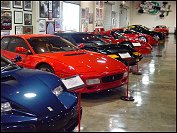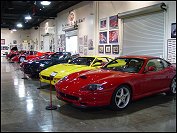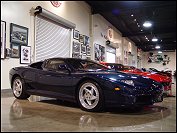| The
Marconi Museum
By
Drew Phillips (edited by JM)
Photography by the author
THE MAN
Dick Marconi is an incredible man. Starting from
nothing, he created the largest manufacturer of vitamins, food supplements
and weight loss products in the entire world. He is a successful race car
driver, being the oldest person to ever qualify for the Vintage F1/F5000
event at the Long Beach Grand Prix. He has built up an impressive car
collection with over 100 rare and exotic cars. Most importantly, Marconi
formed the Marconi Automotive Museum and Foundation for Kids. With
Marconi's help, the museum and foundation has donated several millions of
dollars to at-risk youth and over thirty charitable organizations. In this
unique way, Marconi lives out his motto of "learn, earn, and
return".
THE MUSEUM / FOUNDATION
In the early 1990's, Marconi realized that his
collection of cars could be put to good use. Marconi had a passion for
children, especially at-risk children, and he believed that he could use
his cars to help them. He established the Marconi Museum and Foundation in
1994 to raise money for children, and it has been open ever since.
So how does the museum generate money for the
foundation? While donations from visitors to the museum generate some
money, most of the revenue comes from events held at the museum, including
proxy slot car races! The 16000 sq ft room can hold up to 500 guests, and
the event coordinators from the museum can plan any type of event from
banquets to award ceremonies. The facility features a state of the art
sound system, and a full theatre projection system, but what really makes
the events special are the cars. At every event the cars are placed
throughout the museum and also outside, greeting guests as they arrive.
The impressive collection of cars makes events incredibly unique and
memorable. One such event held each year is "fight night", which
is a world-title kick boxing competition. Last year the event raised
$230,000 for the foundation.
THE CARS
Dick Marconi's collection contains some of the
rarest exotic cars in the world. Influenced by his Italian background,
many of his cars are Ferraris. He has so many that they take up one whole
side of the museum making up what the museum calls "Ferrari
row". The collection starts out with a vintage 1950 Ferrari 195 S.
This is only the 53rd car that Ferrari built. Next to the 195 S
is one of the rarest cars in the world, a Ferrari FX. This car was
originally made for the Sultan of Brunei. The Sultan, being the richest
man in the world, has a bank account that can easily support his hobby of
collecting cars. He collects so many that he often has car companies make
him cars that don't even exist because he already owns all of their
production cars. The FX is one of these cars. The body was designed by
Pininfarina and the rest of the car is based off the Ferrari 512M. One
interesting aspect of the car is it's transmission, which is a push-button
sequential 6-speed that comes from William's Formula 1 technology.
Although actual production figures are unknown, in between one and eight
of these cars were made. Marconi happened to acquire this car through his
friendship with the Sultan's employees. When the Sultan decided to get rid
of some of his cars, Marconi's friend managed to attain of cars for him.
Besides the FX, Marconi also acquired a green Ferrari 456 Spyder (one of
two made) and a Cizeta Moroder V16T, one of eight made.
Going down the line of Ferraris, there is also a
512TR, 512BB, and a gorgeous F50, one of two in Marconi's collection. Next
to the F50 is its predecessor the F40 and the aforementioned 456 Spyder.
Marconi's Ferrari collection also includes a 355 Berlinetta and a 550
Maranello. The Maranello is Marconi's daily driver along with a Bentley. A
TestaRossa and the second F50 complete Ferrari row. Marconi also owns two
Ferrari Dino 246's, a Ferrari 330 GTC 2+2, and a Ferrari 365 GTB/4 Spyder
(one of fourteen made), but these four cars reside on the other side of
the museum. The Daytona Spyder was originally owned by Sonny and Cher and
is one of Marconi's more expensive Ferraris. During the late 1980's
Marconi turned down over a million dollars from an interested buyer.
Today, it is valued at hundreds of thousands of dollars.
Marconi also loves American muscle cars. One of
his most unique cars is a 1973 DeTomaso Pantera L. The car is powered by a
427 side-oiler V8 and has a nitrous system that pushes the engine to
produce over 1100 hp. Marconi drove the car only once on the street with
the nitrous, and afterwards decided that it had too much power to be
street-able. Along with the Pantera L, a Pantera GTS is also in the
collection. Marconi also owns a Plymouth Superbird and a Shelby GT-350,
two of the greatest American muscle cars of all time. The GT-350 is only
part of Marconi's Mustang collection. He also owns a 1969 Boss Mustang and
a 1970 Mach 1. Current muscle cars such as a 1996 Dodge Viper GTS and a
1999 Plymouth Prowler also reside in the museum.
The collection contains several other supercars
besides the Ferraris including a Jaguar XJ220S TWR (one of five made), a
Lamborghini Countach and several other exotic machines. Classic cars are
also prevalent. Marconi owns a mint-condition Mercedes-Benz 300SL Gullwing,
BMW M1, 1956 Rolls Royce, Marcos GT, Jaguar XKE convertible, and two
classic Lamborghinis: an Espada, and a Jarama 400 GT.
The museum's collection of race cars is also quite
striking. In addition to Marconi's own race cars, he also owns Damon
Hill's 1995 Williams-Renault Formula One Car, Mario Andretti's 1994
Lola-Chevrolet Indy car, and one of Aryton Senna's McLaren-Honda MP4/4 F1
car. Probably the most impressive race car in the collection is Michael
Schumacher's 1996 Ferrari F1 car. This was Schumacher's first year with
Ferrari, making the car all the more special. Marconi actually purchased
all fourteen cars used by Ferrari in the 1996 race season, but ended up
keeping only one and selling the rest.
Although the museum already has quite a
collection, they are always looking for new cars. A few cars on the wanted
list are a McLaren F1, Saleen S7, and an original Shelby 427 Cobra. While
the museum probably has enough money to acquire these cars, they have
decided not to for one main reason: the focus is on kids. I was told
"when you're trying to raise money for kids it's hard to spend money
on cars." The more money the museum spends on cars, the less money
they can give to kids. Because of this, the museum is now trying to
acquire cars on loan. This would involve a short-term (6 months or so)
donation of cars to the museum. For anyone with an exotic car locked away
in a garage, this seems like the perfect opportunity to show off your car
and help a great organization.
If live in or are ever visiting southern
California, a visit to the Marconi Museum is a must. No where else can you
always see so many exotic cars all together in one place. You can take as
many pictures as you want, and you might even see Dick Marconi himself. To
top it all off, your donation to the museum is going to a good cause.
Click
here for a complete gallery of pictures from the Museum
Contact Info:
----------------------
Marconi Automotive Museum
1302 Industrial Drive
Tustin, California 92780
Phone: (714) 258-3001
Web: www.marconimuseum.org
E-Mail: priscillabomoore@aol.com
Images and text © Fast-Autos.net 2003
|













The subject of a recent donation, the
Marconi Museum also owns one of the world's most important surviving
racing automobiles: the Cooper-Climax used by 3-time F1 world champion
Jack Brabham at the 1961 Indianapolis 500. This car, found and restored by
Philippe de Lespinay, put an end to the front-engine Indy-style racing
car era in the United States.

Another feature of the Marconi Museum is
the important collection of original vintage slot cars displayed in
showcases in the racing shop. This collection encompasses the
"classic" era of electric slot car racing, between 1964 and
1973, and includes multiple examples of the best production and
professional racing hand-built cars, motors and parts, most of them in
pristine condition.


One of the rare slot cars is this
well-restored Team Russkit car, built in 1966 by team member Ron Quintana.
The body is a Chaparral 2. These early
cars were used in a racing series organized by Rod & Custom, a popular
period magazine.
|














